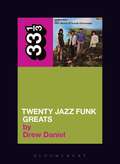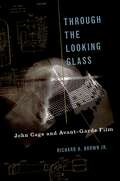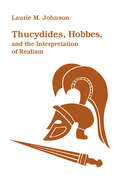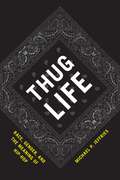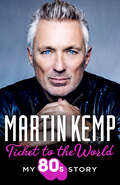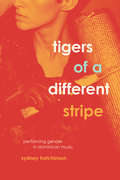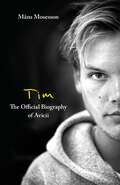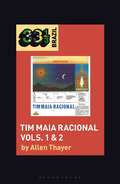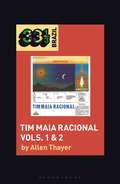- Table View
- List View
Throbbing Gristle's Twenty Jazz Funk Greats (33 1/3)
by Drew DanielIn 20 Jazz Funk Greats Drew Daniel (of the experimental band Matmos) creates-through both his own insights and exclusive interviews with the band-an exploded view of the album's multiple agendas: a series of close readings of each song, shot through with a sequence of thematic entries on key concepts, strategies, and contexts (noise, leisure, process, the abject, information, and repetition). This is a smart and unusual book about a pioneering band.
Throbbing Gristle's Twenty Jazz Funk Greats (33 1/3)
by Drew DanielIn 20 Jazz Funk Greats Drew Daniel (of the experimental band Matmos) creates-through both his own insights and exclusive interviews with the band-an exploded view of the album's multiple agendas: a series of close readings of each song, shot through with a sequence of thematic entries on key concepts, strategies, and contexts (noise, leisure, process, the abject, information, and repetition). This is a smart and unusual book about a pioneering band.
Through The Looking Glass: John Cage and Avant-Garde Film (Oxford Music/Media Series)
by Richard H. BrownThrough the Looking Glass examines John Cage's interactions and collaborations with avant-garde and experimental filmmakers, and in turn seeks out the implications of the audiovisual experience for the overall aesthetic surrounding Cage's career. As the commercially dominant media form in the twentieth century, cinema transformed the way listeners were introduced to and consumed music. Cage's quest to redefine music, intentionality, and expression reflect the similar transformation of music within the larger audiovisual experience of sound film. This volume examines key moments in Cage's career where cinema either informed or transformed his position on the nature of sound, music, expression, and the ontology of the musical artwork. The examples point to moments of rupture within Cage's own consideration of the musical artwork, pointing to newfound collision points that have a significant and heretofore unacknowledged role in Cage's notions of the audiovisual experience and the medium-specific ontology of a work of art.
Through My Eyes
by Cheryl ColeThrough My Eyes is the first official book from Cheryl Cole. Featuring a series of stunning exclusive new photos plus informal shots from her own personal collection, it gives us a unique glimpse into the life of our favourite star.From the recording studio in LA as she works on her debut album to backstage in Dublin on the opening night of her tour with the Black Eyed Peas, Cheryl shares with us some of her stand-out moments as a solo artist. We also explore the other elements of her stratospherically successful career as she takes us behind the scenes at The X Factor, into the world of L'Oreal, through the music industry's top awards ceremonies and into the windswept desert in California for a spectacular shoot under freezing conditions where we see her taking time off and enjoying rare moments of anonymity. Through the pictures that mean the most to her and their stories, which are told in her own words, Through My Eyes is a revealing and intimate portrait of the world of Cheryl Cole.
THROUGH THE LOOKING GLASS OMMS C: John Cage and Avant-Garde Film (Oxford Music/Media Series)
by Richard H. BrownThrough the Looking Glass examines John Cage's interactions and collaborations with avant-garde and experimental filmmakers, and in turn seeks out the implications of the audiovisual experience for the overall aesthetic surrounding Cage's career. As the commercially dominant media form in the twentieth century, cinema transformed the way listeners were introduced to and consumed music. Cage's quest to redefine music, intentionality, and expression reflect the similar transformation of music within the larger audiovisual experience of sound film. This volume examines key moments in Cage's career where cinema either informed or transformed his position on the nature of sound, music, expression, and the ontology of the musical artwork. The examples point to moments of rupture within Cage's own consideration of the musical artwork, pointing to newfound collision points that have a significant and heretofore unacknowledged role in Cage's notions of the audiovisual experience and the medium-specific ontology of a work of art.
Thucydides, Hobbes, and the Interpretation of Realism
by Laurie M. JohnsonThis original book has been consistently cited by scholars of international relations who explore the roots of realism in Thucydides's history and the political philosophy of Thomas Hobbes. While acknowledging that neither thinker fits perfectly within the confines of international relations realism, Laurie M. Johnson proposes Hobbes's philosophy is more closely aligned with it than Thucydides's.
Thug Life: Race, Gender, and the Meaning of Hip-Hop
by Michael P. JeffriesHip-hop has come a long way from its origins in the Bronx in the 1970s, when rapping and DJing were just part of a lively, decidedly local scene that also venerated b-boying and graffiti. Now hip-hop is a global phenomenon and, in the United States, a massively successful corporate enterprise predominantly controlled and consumed by whites while the most prominent performers are black. How does this shift in racial dynamics affect our understanding of contemporary hip-hop, especially when the music perpetuates stereotypes of black men? Do black listeners interpret hip-hop differently from white fans? These questions have dogged hip-hop for decades, but unlike most pundits, Michael P. Jeffries finds answers by interviewing everyday people. Instead of turning to performers or media critics, Thug Life focuses on the music’s fans—young men, both black and white—and the resulting account avoids romanticism, offering an unbiased examination of how hip-hop works in people’s daily lives. As Jeffries weaves the fans’ voices together with his own sophisticated analysis, we are able to understand hip-hop as a tool listeners use to make sense of themselves and society as well as a rich, self-contained world containing politics and pleasure, virtue and vice.
Thug Life: Race, Gender, and the Meaning of Hip-Hop
by Michael P. JeffriesHip-hop has come a long way from its origins in the Bronx in the 1970s, when rapping and DJing were just part of a lively, decidedly local scene that also venerated b-boying and graffiti. Now hip-hop is a global phenomenon and, in the United States, a massively successful corporate enterprise predominantly controlled and consumed by whites while the most prominent performers are black. How does this shift in racial dynamics affect our understanding of contemporary hip-hop, especially when the music perpetuates stereotypes of black men? Do black listeners interpret hip-hop differently from white fans? These questions have dogged hip-hop for decades, but unlike most pundits, Michael P. Jeffries finds answers by interviewing everyday people. Instead of turning to performers or media critics, Thug Life focuses on the music’s fans—young men, both black and white—and the resulting account avoids romanticism, offering an unbiased examination of how hip-hop works in people’s daily lives. As Jeffries weaves the fans’ voices together with his own sophisticated analysis, we are able to understand hip-hop as a tool listeners use to make sense of themselves and society as well as a rich, self-contained world containing politics and pleasure, virtue and vice.
Thug Life: Race, Gender, and the Meaning of Hip-Hop
by Michael P. JeffriesHip-hop has come a long way from its origins in the Bronx in the 1970s, when rapping and DJing were just part of a lively, decidedly local scene that also venerated b-boying and graffiti. Now hip-hop is a global phenomenon and, in the United States, a massively successful corporate enterprise predominantly controlled and consumed by whites while the most prominent performers are black. How does this shift in racial dynamics affect our understanding of contemporary hip-hop, especially when the music perpetuates stereotypes of black men? Do black listeners interpret hip-hop differently from white fans? These questions have dogged hip-hop for decades, but unlike most pundits, Michael P. Jeffries finds answers by interviewing everyday people. Instead of turning to performers or media critics, Thug Life focuses on the music’s fans—young men, both black and white—and the resulting account avoids romanticism, offering an unbiased examination of how hip-hop works in people’s daily lives. As Jeffries weaves the fans’ voices together with his own sophisticated analysis, we are able to understand hip-hop as a tool listeners use to make sense of themselves and society as well as a rich, self-contained world containing politics and pleasure, virtue and vice.
Thug Life: Race, Gender, and the Meaning of Hip-Hop
by Michael P. JeffriesHip-hop has come a long way from its origins in the Bronx in the 1970s, when rapping and DJing were just part of a lively, decidedly local scene that also venerated b-boying and graffiti. Now hip-hop is a global phenomenon and, in the United States, a massively successful corporate enterprise predominantly controlled and consumed by whites while the most prominent performers are black. How does this shift in racial dynamics affect our understanding of contemporary hip-hop, especially when the music perpetuates stereotypes of black men? Do black listeners interpret hip-hop differently from white fans? These questions have dogged hip-hop for decades, but unlike most pundits, Michael P. Jeffries finds answers by interviewing everyday people. Instead of turning to performers or media critics, Thug Life focuses on the music’s fans—young men, both black and white—and the resulting account avoids romanticism, offering an unbiased examination of how hip-hop works in people’s daily lives. As Jeffries weaves the fans’ voices together with his own sophisticated analysis, we are able to understand hip-hop as a tool listeners use to make sense of themselves and society as well as a rich, self-contained world containing politics and pleasure, virtue and vice.
Thug Life: Race, Gender, and the Meaning of Hip-Hop
by Michael P. JeffriesHip-hop has come a long way from its origins in the Bronx in the 1970s, when rapping and DJing were just part of a lively, decidedly local scene that also venerated b-boying and graffiti. Now hip-hop is a global phenomenon and, in the United States, a massively successful corporate enterprise predominantly controlled and consumed by whites while the most prominent performers are black. How does this shift in racial dynamics affect our understanding of contemporary hip-hop, especially when the music perpetuates stereotypes of black men? Do black listeners interpret hip-hop differently from white fans? These questions have dogged hip-hop for decades, but unlike most pundits, Michael P. Jeffries finds answers by interviewing everyday people. Instead of turning to performers or media critics, Thug Life focuses on the music’s fans—young men, both black and white—and the resulting account avoids romanticism, offering an unbiased examination of how hip-hop works in people’s daily lives. As Jeffries weaves the fans’ voices together with his own sophisticated analysis, we are able to understand hip-hop as a tool listeners use to make sense of themselves and society as well as a rich, self-contained world containing politics and pleasure, virtue and vice.
Thug Life: Race, Gender, and the Meaning of Hip-Hop
by Michael P. JeffriesHip-hop has come a long way from its origins in the Bronx in the 1970s, when rapping and DJing were just part of a lively, decidedly local scene that also venerated b-boying and graffiti. Now hip-hop is a global phenomenon and, in the United States, a massively successful corporate enterprise predominantly controlled and consumed by whites while the most prominent performers are black. How does this shift in racial dynamics affect our understanding of contemporary hip-hop, especially when the music perpetuates stereotypes of black men? Do black listeners interpret hip-hop differently from white fans? These questions have dogged hip-hop for decades, but unlike most pundits, Michael P. Jeffries finds answers by interviewing everyday people. Instead of turning to performers or media critics, Thug Life focuses on the music’s fans—young men, both black and white—and the resulting account avoids romanticism, offering an unbiased examination of how hip-hop works in people’s daily lives. As Jeffries weaves the fans’ voices together with his own sophisticated analysis, we are able to understand hip-hop as a tool listeners use to make sense of themselves and society as well as a rich, self-contained world containing politics and pleasure, virtue and vice.
Ticket to the World: My 80s Story
by Martin KempTicket to the World is a joyous, nostalgic celebration of 80s culture from one man at the centre of it all.
A Tidal Wave of Encouragement: American Composers' Concerts in the Gilded Age (Non-ser.)
by E. Douglas BombergerIn July of 1884, pianist Calixa Lavallée performed a recital of works by American composers that began a highly influential series of such concerts. Over the course of the next decade, hundreds of all-American concerts were performed in the United States and Europe, a movement that fostered both the development and the perception of American music as a unique art form. A Tidal Wave of Encouragement-the title of which is derived from one observer's description of the movement-is the first in-depth study of this significant period in American music. Providing a comprehensive history of the Concerts as well as detailed accounts of the intense critical debate surrounding them, author E. Douglas Bomberger reveals how one decade shaped the future of American classical music and very much impacted the way we hear it today.The movement, crucial in focusing discussion on American music and providing performance opportunities for composers and musicians for whom no such opportunities had before existed, was far more extensive and widespread than most scholarship had credited it. This oversight is due in large part to the dearth of objective studies of the Concerts; previous considerations have tended either toward the merely nostalgic or toward the unnecessarily disparaging. Bomberger's work is a corrective to this, as well as much-needed historical and critical account of a project whose influence had yet to be fully acknowledged.
Tiefenresonanz: Klang, Körper und die Erfahrung sonischer Materialität von Drone Music (Transdisziplinäre Popkulturstudien #5)
by Luise WolfDie Drone Music von The Haxan Cloak bespielt den Körper und macht ihn in seiner Tiefenresonanz spürbar. Hörer*innen erleben eine ›ganze Welt‹, andere verlieren sich darin, empfinden Angst, Leere oder Ohnmacht. Welche Rezeptionsweisen führen zu so unterschiedlichen Hörerfahrungen? Wie kann Musik, die die Sinne überwältigt, andere Selbst- und Wirklichkeitserfahrungen evozieren? Luise Wolf verschränkt kunst- und kulturwissenschaftliche mit (psycho-)akustischen Perspektiven, um die Resonanz in ihren leiblich-reflexiven und künstlerisch-materiellen Bedingungen zu ergründen.
Tigers of a Different Stripe: Performing Gender in Dominican Music (Chicago Studies in Ethnomusicology)
by Sydney HutchinsonTigers of a Different Stripe takes readers inside the unique world of merengue típico, a traditional music of the Dominican Republic. While in most genres of Caribbean music women usually participate as dancers or vocalists, in merengue típico they are more often instrumentalists and even bandleaders—something nearly unheard of in the macho Caribbean music scene. Examining this cultural phenomenon, Sydney Hutchinson offers an unexpected and fascinating account of gender in Dominican art and life. Drawing on over a decade of fieldwork in the Dominican Republic and New York among musicians, fans, and patrons of merengue típico—not to mention her own experiences as a female instrumentalist—Hutchinson details a complex nexus of class, race, and artistic tradition that unsettles the typical binary between the masculine and feminine. She sketches the portrait of the classic male figure of the tíguere, a dandified but sexually aggressive and street-smart “tiger,” and she shows how female musicians have developed a feminine counterpart: the tíguera, an assertive, sensual, and respected female figure who looks like a woman but often plays and even sings like a man. Through these musical figures and studies of both straight and queer performers, she unveils rich ambiguities in gender construction in the Dominican Republic and the long history of a unique form of Caribbean feminism.
Tigers of a Different Stripe: Performing Gender in Dominican Music (Chicago Studies in Ethnomusicology)
by Sydney HutchinsonTigers of a Different Stripe takes readers inside the unique world of merengue típico, a traditional music of the Dominican Republic. While in most genres of Caribbean music women usually participate as dancers or vocalists, in merengue típico they are more often instrumentalists and even bandleaders—something nearly unheard of in the macho Caribbean music scene. Examining this cultural phenomenon, Sydney Hutchinson offers an unexpected and fascinating account of gender in Dominican art and life. Drawing on over a decade of fieldwork in the Dominican Republic and New York among musicians, fans, and patrons of merengue típico—not to mention her own experiences as a female instrumentalist—Hutchinson details a complex nexus of class, race, and artistic tradition that unsettles the typical binary between the masculine and feminine. She sketches the portrait of the classic male figure of the tíguere, a dandified but sexually aggressive and street-smart “tiger,” and she shows how female musicians have developed a feminine counterpart: the tíguera, an assertive, sensual, and respected female figure who looks like a woman but often plays and even sings like a man. Through these musical figures and studies of both straight and queer performers, she unveils rich ambiguities in gender construction in the Dominican Republic and the long history of a unique form of Caribbean feminism.
Tigers of a Different Stripe: Performing Gender in Dominican Music (Chicago Studies in Ethnomusicology)
by Sydney HutchinsonTigers of a Different Stripe takes readers inside the unique world of merengue típico, a traditional music of the Dominican Republic. While in most genres of Caribbean music women usually participate as dancers or vocalists, in merengue típico they are more often instrumentalists and even bandleaders—something nearly unheard of in the macho Caribbean music scene. Examining this cultural phenomenon, Sydney Hutchinson offers an unexpected and fascinating account of gender in Dominican art and life. Drawing on over a decade of fieldwork in the Dominican Republic and New York among musicians, fans, and patrons of merengue típico—not to mention her own experiences as a female instrumentalist—Hutchinson details a complex nexus of class, race, and artistic tradition that unsettles the typical binary between the masculine and feminine. She sketches the portrait of the classic male figure of the tíguere, a dandified but sexually aggressive and street-smart “tiger,” and she shows how female musicians have developed a feminine counterpart: the tíguera, an assertive, sensual, and respected female figure who looks like a woman but often plays and even sings like a man. Through these musical figures and studies of both straight and queer performers, she unveils rich ambiguities in gender construction in the Dominican Republic and the long history of a unique form of Caribbean feminism.
Tigers of a Different Stripe: Performing Gender in Dominican Music (Chicago Studies in Ethnomusicology)
by Sydney HutchinsonTigers of a Different Stripe takes readers inside the unique world of merengue típico, a traditional music of the Dominican Republic. While in most genres of Caribbean music women usually participate as dancers or vocalists, in merengue típico they are more often instrumentalists and even bandleaders—something nearly unheard of in the macho Caribbean music scene. Examining this cultural phenomenon, Sydney Hutchinson offers an unexpected and fascinating account of gender in Dominican art and life. Drawing on over a decade of fieldwork in the Dominican Republic and New York among musicians, fans, and patrons of merengue típico—not to mention her own experiences as a female instrumentalist—Hutchinson details a complex nexus of class, race, and artistic tradition that unsettles the typical binary between the masculine and feminine. She sketches the portrait of the classic male figure of the tíguere, a dandified but sexually aggressive and street-smart “tiger,” and she shows how female musicians have developed a feminine counterpart: the tíguera, an assertive, sensual, and respected female figure who looks like a woman but often plays and even sings like a man. Through these musical figures and studies of both straight and queer performers, she unveils rich ambiguities in gender construction in the Dominican Republic and the long history of a unique form of Caribbean feminism.
Tigers of a Different Stripe: Performing Gender in Dominican Music (Chicago Studies in Ethnomusicology)
by Sydney HutchinsonTigers of a Different Stripe takes readers inside the unique world of merengue típico, a traditional music of the Dominican Republic. While in most genres of Caribbean music women usually participate as dancers or vocalists, in merengue típico they are more often instrumentalists and even bandleaders—something nearly unheard of in the macho Caribbean music scene. Examining this cultural phenomenon, Sydney Hutchinson offers an unexpected and fascinating account of gender in Dominican art and life. Drawing on over a decade of fieldwork in the Dominican Republic and New York among musicians, fans, and patrons of merengue típico—not to mention her own experiences as a female instrumentalist—Hutchinson details a complex nexus of class, race, and artistic tradition that unsettles the typical binary between the masculine and feminine. She sketches the portrait of the classic male figure of the tíguere, a dandified but sexually aggressive and street-smart “tiger,” and she shows how female musicians have developed a feminine counterpart: the tíguera, an assertive, sensual, and respected female figure who looks like a woman but often plays and even sings like a man. Through these musical figures and studies of both straight and queer performers, she unveils rich ambiguities in gender construction in the Dominican Republic and the long history of a unique form of Caribbean feminism.
Tigers of a Different Stripe: Performing Gender in Dominican Music (Chicago Studies in Ethnomusicology)
by Sydney HutchinsonTigers of a Different Stripe takes readers inside the unique world of merengue típico, a traditional music of the Dominican Republic. While in most genres of Caribbean music women usually participate as dancers or vocalists, in merengue típico they are more often instrumentalists and even bandleaders—something nearly unheard of in the macho Caribbean music scene. Examining this cultural phenomenon, Sydney Hutchinson offers an unexpected and fascinating account of gender in Dominican art and life. Drawing on over a decade of fieldwork in the Dominican Republic and New York among musicians, fans, and patrons of merengue típico—not to mention her own experiences as a female instrumentalist—Hutchinson details a complex nexus of class, race, and artistic tradition that unsettles the typical binary between the masculine and feminine. She sketches the portrait of the classic male figure of the tíguere, a dandified but sexually aggressive and street-smart “tiger,” and she shows how female musicians have developed a feminine counterpart: the tíguera, an assertive, sensual, and respected female figure who looks like a woman but often plays and even sings like a man. Through these musical figures and studies of both straight and queer performers, she unveils rich ambiguities in gender construction in the Dominican Republic and the long history of a unique form of Caribbean feminism.
Tim – The Official Biography of Avicii
by Måns MosessonThe intimate biography of the iconic DJ who was lost too soon.Like a firework against the night sky, the DJ and producer Tim Bergling exploded onto the music scene. A musical visionary who, through his sense for melodies, came to define the era when Swedish and European house music took over the world.But Tim Bergling was also an introverted and fragile young man who was forced to grow up at an inhumanly fast pace. After a series of emergencies resulting in hospital stays, he stopped touring in the summer of 2016. Barely two years later, he took his own life.Tim - The Biography of Avicii is written by the award-winning journalist Måns Mosesson, who was given unique access to Tim's own notes, as well as interviews with Tim's family, friends and colleagues in the music business. The book paints an honest picture of Tim and his search in life, not shying from the difficulties that he struggled with.
Tim Book Two: Vinyl Adventures from Istanbul to San Francisco
by Tim BurgessTim Book Two is the follow-up to Telling Stories, the hugely successful memoir of Tim Burgess, singer of the Charlatans. In 2012, Tim published his hugely successful and critically acclaimed memoir, Telling Stories. Tim really enjoyed his new role as an author, and so here it is: Tim Book Two - a tale of Tim's lifelong passion for records, the shops that sell them, and the people who make them. In some ways, the biggest events in Tim's life happened in the couple of years after he had finished writing his first book rather than in the forty years before. So he had more to say, but instead of another autobiography he chose a different way of telling the story. Tim set himself a quest. He would get in touch with people he admired, and ask them to suggest an album for him to track down on his travels, giving an insight into what makes them tick. It would also offer a chance to see how record shops were faring in the digital age - one in which vinyl was still a much-treasured format.Tim assembled his cast of characters, from Iggy Pop to Johnny Marr, David Lynch to Cosey Fanni Tutti. Texts, phone calls, emails and handwritten notes went out. Here is the tender, funny and surprising story of what came back.
Tim Maia's Tim Maia Racional Vols. 1 & 2 (33 1/3 Brazil)
by Allen ThayerAt the height of Tim Maia's soaring fame, he joined a radical, extraterrestrial-obsessed cult and created two plus albums of some of Brazil's-and the globe's-best funk and soul music. This book explores the career of the man often hailed as the James Brown or Barry White of Brazil, and the time of his radical transformation from a musician notorious for hedonistic living to a devoted follower of Manoel Jacinto Coelho's Rational Culture.After suddenly joining Coelho's cult in 1974 (which started first as an offshoot of the mystical Afro-Brazilian religion Umbanda), Maia gave up drugs and alcohol, threw away his material possessions, and released Racional Vols. 1 & 2 in the attempt to convert the entirety of Brazil and the world to the revelation of Rational Culture. Thayer explores this strange, brief, yet incredibly prolific period of Maia's life wherein the reigning soul and funk artist of Brazil produced two albums, an EP, and a recently unearthed tape containing almost another full album of funky jams laced with spiritual content and scripture. For just as quickly as Maia became entranced with Coelho did he become disillusioned with the cult, disavowing and destroying everything having to do with that experience and refusing to speak of it for the rest of his life.33 1/3 Global, a series related to but independent from 33 1/3, takes the format of the original series of short, music-based books and brings the focus to music throughout the world. With initial volumes focusing on Japanese and Brazilian music, the series will also include volumes on the popular music of Australia/Oceania, Europe, Africa, the Middle East, and more.
Tim Maia's Tim Maia Racional Vols. 1 & 2 (33 1/3 Brazil Ser.)
by Mr Allen ThayerAt the height of Tim Maia's soaring fame, he joined a radical, extraterrestrial-obsessed cult and created two plus albums of some of Brazil's-and the globe's-best funk and soul music. This book explores the career of the man often hailed as the James Brown or Barry White of Brazil, and the time of his radical transformation from a musician notorious for hedonistic living to a devoted follower of Manoel Jacinto Coelho's Rational Culture.After suddenly joining Coelho's cult in 1974 (which started first as an offshoot of the mystical Afro-Brazilian religion Umbanda), Maia gave up drugs and alcohol, threw away his material possessions, and released Racional Vols. 1 & 2 in the attempt to convert the entirety of Brazil and the world to the revelation of Rational Culture. Thayer explores this strange, brief, yet incredibly prolific period of Maia's life wherein the reigning soul and funk artist of Brazil produced two albums, an EP, and a recently unearthed tape containing almost another full album of funky jams laced with spiritual content and scripture. For just as quickly as Maia became entranced with Coelho did he become disillusioned with the cult, disavowing and destroying everything having to do with that experience and refusing to speak of it for the rest of his life.33 1/3 Global, a series related to but independent from 33 1/3, takes the format of the original series of short, music-based books and brings the focus to music throughout the world. With initial volumes focusing on Japanese and Brazilian music, the series will also include volumes on the popular music of Australia/Oceania, Europe, Africa, the Middle East, and more.
